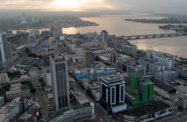
– Ghana has long sought to drive growth through industrialisation
– Plans for three industrial cities announced at the end of last year
– The GFZA manages a series of industrial and export-focused facilities
– The AfCFTA could boost African exports by 29% by 2035

With a focus on driving broader economic development through both manufacturing and the establishment of special economic zones (SEZs), Ghana is looking to capitalise on the benefits associated with the African Continental Free Trade Area (AfCFTA).
Ghana has long sought to increase its industrial capacity as a way of creating jobs and stimulating GDP growth.
Key to this have been government efforts to improve the country’s industrial infrastructure, in part by establishing programmes designed to expand industrial parks and SEZs.
While SEZs and industrial zones have formed part of Ghana’s strategic economic plans for some decades, the country has recently reaffirmed its focus on them as a way to stimulate GDP growth following two years of the Covid-19 pandemic.
For example, in December it was announced that Ghana would build three industrial city developments, located in the Ashanti, Eastern and Western regions.
The projects, which will add to existing industrial and processing zones, form part of the government’s transformation plan, which envisages Ghana as a key processing and exporting country.
GFZA plays key role
Central to the government’s strategy is the Ghana Free Zones Authority (GFZA). Created in 1995, the GFZA is a government institution tasked with facilitating the development of economic zones around the country.
The authority’s roles include developing logistics facilities and managing various financial incentives designed to attract both domestic and foreign companies to the zones.
For example, GFZA-managed sites provide investors with various tax and import duty exemptions, along with relief from bureaucratic processes, import licensing requirements and restrictions on financial repatriation.
The GFZA manages four sites, known as export processing zones (EPZs), in strategic locations across Ghana. One of the most important is the Tema EPZ, which is located close to the country’s largest port and 25 km from Accra’s international airport.
Elsewhere, the authority manages the Sekondi EPZ, located next to the second-largest port and with access to key road links to industrial plants; the Shama EPZ, a petrochemical zone in the Western Region; and Ashanti Technology Park, which hosts several clusters that include businesses engaged in cocoa processing, social services, biotechnology and ICT.
In a sign of their economic impact, during the first half of 2021 businesses operating within GFZA sites generated $1.1bn in export revenue, attracted $173.8m in capital investment and created more than 30,000 jobs.
Crucially, however, EPZ benefits are not limited to a specific geographic area.
"Investors do not necessarily have to set up operations within any of the four existing EPZs. What distinguishes the Ghana free zones regime is its ubiquity; licensed companies are free to set up their operations anywhere in Ghana,” Michael Oquaye, CEO of the GFZA, told OBG.
AfCFTA boost
The implementation of the AfCFTA has further reinforced the strategic value of Ghana’s industrial zones.
Launched on January 1, 2021, the free trade area brings together 54 of the 55 members of the African Union – a market with a combined GDP of $3.4trn. It aims to create a single market for goods, services and the movement of people, with plans to abolish tariffs on 90% of goods produced within the zone.
The economic impact is expected to be significant. The World Bank anticipates that the AfCFTA could boost African exports by 29%, or around $560bn, and lift more than 30m people out of extreme poverty by 2035. Significantly for Ghana, West Africa is expected to see rising numbers of people join the middle class.
Meanwhile, according to the UN Economic Commission for Africa, the AfCFTA could boost intra-African trade by 40-50% by 2040, with intra-African exports forecast to increase by 25-30% by that time.
In light of this potential, the GFZA has been working with regulators across the continent since the launch of the free trade area to develop new SEZ regulations to facilitate and improve the trade of goods among AfCFTA members.
“The creation of a large continental market through the AfCFTA is closely linked to the development and expansion of SEZs,” Oquaye told OBG at the end of last year.
“This is largely due to their capacity to facilitate trade flows and attract investment from both domestic and foreign companies. Indeed, such zones can help create thousands of jobs tailored for a skilled workforce, as well as boost economic and social development across the continent.”



